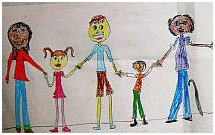
So far, we’ve covered how attachment styles affect babies and individuals, but what about attachment styles in relationships and marriages?
Have you ever heard the theory that we pick partners who are similar to our parents? I have wondered about this over the years. My life partner, Gal is similar to my dad in some ways and totally different in many other ways. He is also similar to my mom in some ways and totally different to her in many other ways. I find it hard to either confirm or deny the theory.
While it is hard to decide if this theory works based on personal attributes, attachment theory claims that in some strange way we relate and attach to our partners and in a way that matches the attachment style that was created between us and our caregivers in those first years of our lives.
Based on attachment theory, these are the four styles we develop in childhood:
- Secure attachment – The baby is very happy when the caregiver is around, becomes sad and upset when they leave but feels confident they will be back. Baby is very happy to see them when they come back. In teen years, this will be when the teen can go to the caregiver to express feelings and ask for help.
- Ambivalent attachment – The baby is extremely upset when the caregiver leaves and cannot trust the caregiver in situations of fear and danger. The baby can become aggressive towards the caregiver when he/she returns. When the baby becomes a teen, and ambivalent teen can become quite angry and learns that the parents is not available to help, is a source of fear or abuse.
- Avoidant attachment – babies with avoidant attachment will feel stressed (similar to all attachment styles) when the caregiver leaves the room but will ignore them when they come back. In teen years, the teenager may experience challenges and problems but will avoid expressing feelings about this and will not ask for help even in situations where help from parents is critical.
- Disorganized attachment – Is when there is no clear attachment style. In this case, the baby portrays a mixture of aggression and avoidance towards the caregiver. They may go to mom on her return, but hit her for leaving and then avoid her “as punishment”. These kids often seem disoriented and confused. Research suggests this is a result of inconsistent behavior by the main caregivers, or when the parent is source of comfort and a source of fear at the same time. Teens with disorganized attachment styles can seem very disoriented and confused. They can be both aggressive and reserved, which makes them seem “chaotic” and unpredictable. Their behavior portrays the feeling, “I hate it when I need you and… I don’t need your help”.
Attachment styles in relationships and marriage

The attachment style is revealed not in times of love or during the emotional honeymoon, but during crisis. The way we manage the conflicts between us will determine how we relate to each other. This is when our early years attachment or the teen attachment style will become the map with which we navigate the relationship.

Avoidant attachment can lead to critical, rigid and distant relationships. In this relationship, there can be a lack of trust and inflexibility. For avoidant couples, intimacy is risky and there is a form of fear in their relationship (maybe from each other or from feeling exposed and vulnerable, for fear of getting hurt). People who have this attachment style often do not stand up for themselves and blame themselves when others are aggressive and controlling. Their main goal is to avoid conflict. They will let their partner make the decisions to avoid arguments and give up expressing their wants and desires in the relationship. They tend to bottle up their emotions and feel very lonely in the relationship.
Ambivalent attachment can lead to anxious and insecure relationships. It can lead to controlling and unpredictable relationship, “blaming” and “accounting” – trying to balance the pain (e.g. “You hurt me, I will hurt you”). A person with ambivalent attachment may try to fix the other partner, control his/her actions or even thoughts. This can easily lead to trying to control other things such as, who they talk to and how often, what they buy, how they manage their time and many other things.
Disorganized attachment can lead to anxious, insensitive, chaotic and explosive relationship (a bit like the relationship has bi-polar). These relationship are often abusive and needy but lacking in trust. The disorganized person will have exhibit similar characteristics to the avoidant and ambivalent attachment. These relationships can suffer huge ups and downs and lots of pain and heartache.

Meanwhile, an insecure person will either avoid conflicts, be aggressive in conflicts or be disorganized (alternating between avoiding and being aggressive).
If you want to know your attachment style, ask yourself what happens when you experience conflict:
- Do I stay calm? (Secure)
- Do I try to stop the argument, run away, cry, not share my true feelings, feel afraid, hide? (Avoidant)
- Do I raise my voice, shout, use insults and name calling, am I controlling, critical, sarcastic, insensitive, aggressive, abusive and use verbal and non verbal violence, use threats and conditions to my attention and relationship? (Ambivalent- aggressive)
It is rare to find couples that are both totally secure in their relationships. Many kids these days experience divorce and separation from their parents that some form of trust is broken. They have proof that relationships equal pain so they often start their own relationships feeling insecure. This can have a long term impact on relationships.
How to Change Attachment Styles in Relationships and Marriages
This week, I had a client who was 42 years old. Her parents divorced when she was 13. She had a great relationship with each of them but every time she talked about their divorce she cried. It was almost 20 years ago and she still suffered from it. She came to me to discuss her relationship with her husband. She realized she was transferring the distrust she had in her parents to her husband. Every tiny thing he did makes her think about how similar he was to her dad or her mom, she alternated between being avoidant and aggressive. The was going to lead her to the exact place she was trying to avoid – divorce. The insecurity is something that lasts for a long time after and can sabotage every good love between two people.

- With your parents. Go through family therapy with your parents to overcome your attachment.
- Do some work with a professional therapist or life coach to make some fundamental changes in your blueprint. NLP is a great way to do that.
An attachment style is not something we choose. It happens in childhood and leaves a lasting impression that can be difficult to overcome. On a positive note, I hope reading this series has planted some of the following ideas in your mind:
- If you are insecure. It is not your fault. You can only deal with what you have now.
- Our relationship with our parents in those early years creates a map with which we navigate life.
- Our map gets re-done in our teen years. Parents get a second chance to fix the map or make it more solid and secure.
- We take this blueprint to all of our relationships.
- We can identify what attachment style we have by seeing how we handle conflict.
- Lastly, we can always, always, always chose to get some help and change. Because we deserve to be secure and happy.
Happy attachments!
Ronit
* Image by Charles McArthur from Pixabay
This post is part of the series Attachment Theory:
- Attachment Theory: Main Characteristics of Attachment
- Attachment Theory: Four Attachment Styles
- Attachment Theory: Insecure Attachment Style
- Attachment Theory: Secure and Insecure Attachment in Adult Life
- Attachment Theory: Secure and Insecure Attachment in Teenagers
- Attachment Theory: Attachment Styles in Relationships and Marriages











